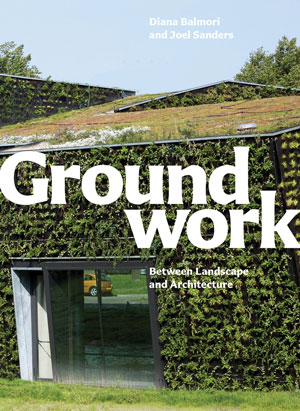In Groundwork, landscape architect Diana Balmori and architect Joel Sanders explore the territory between their fields, which is often painted—falsely, they write—as a dichotomy. “An integrated practice of landscape and architecture could have dramatic environmental consequences: the disciplines would cease to have separate agendas and would instead allow for buildings and landscapes to perform as linked interactive systems that heal the environment.” It is tantalizing, despite the hubris behind the idea that people or designers can “heal” nature. Ecologists and biologists maintain that the best way to heal an ecosystem is to connect it to more of itself. On the other hand, a major problem with the philosophical underpinnings of sustainable design may be our failure to understand humans as part of nature itself.

Balmori and Sanders seek “interface”— the possibility of unifying their design disciplines. “This awareness of the environment as a complex system puts architecture and landscape on equivalent terms and will encourage practitioners to create designs that approach the efficiency and performance standards of a living being,” they write. (Maybe a little beauty, too? We fickle organisms have shown a tendency to care for designs that we love.)
Sanders’ opening essay provides historical perspective for the concept of wilderness. Then Balmori explores the ”interface” between nature and culture, showing how it informs precedents for the book’s 25 built and unbuilt projects at various scales. Several of the unbuilt works are unconvincing because they represent vegetation and topography in coldly synthetic ways.
The book organizes works into three categories: Topography, Ecology, and Biocomputation. The first one focuses on projects that are primarily driven by formal concerns: “Instead of resorting to a naturalistic vocabulary, they invent a shared landscape/architecture expression that makes a bold imprint on the land.” Among the nine projects in this section are Toyo Ito’s biomorphic Grin Grin building in Fukuoka, Japan, and Weiss/Manfredi’s zig-zagging Olympic Sculpture Park in Seattle.
The second section, Ecology, looks at designers who are “interested in unleashing the creative potential of sustainability.” Some of the projects here are fanciful and imaginative; others include elements—such as growing walls and roofs—that seem simplistic. The best ones find new ways to bring buildings alive with vegetation, such as the Eco-Pod temporary tower for micro-algae farming by Höwler+Yoon Architecture and Squared Design Lab. Snøhetta’s Turistroute in Eggum, Norway, is haunting and sculptural, recalling Robert Smithson’s earthworks from the 1960s. The angular Parque Atlantico appears to provide an amazing experience—the perfect counterpoint to the Olmsted’s constructed “wilderness.”
The chapter on Biocomputation, which explores digital design, is the most diverse. Here the unbuilt New Czech National Library by OCEAN North and Scheffler + Partners shows how parametric design enabled the team to design something that “not only looks like a linden tree but behaves like one.”
In the book's first sentence, Balmori and Sanders criticize other books on landscape that "romanticize nature as a universal palliative and bid designers to consult the 'genius of place.'" Instead, they propose finding a "union" between architecture and landscape to help address "urgent ecological concerns." As a way of framing a collection of new and conceptual work, such an approach is persuasive.
Kira Gould writes about design, sustainability, and culture, and is the co-author of Women in Green: Voices of Sustainable Design (Ecotone Publishing, 2007).




Post a comment to this article
Report Abusive Comment